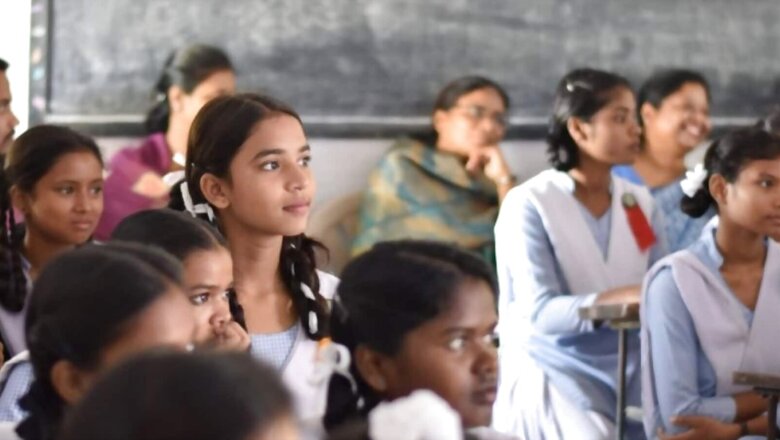
views
In four years of implementation of the centralised medical entrance exam – NEET – there has been a shift of students from the TNBSE to CBSE. The post-Neet phase saw a 31% increase in students applying from CBSE and a 30% fall in students from TNSBSE, according to a report on the ‘Impact of NEET on Medical Admissions in Tamil Nadu’.
Since NEET is skewed towards the CBSE syllabus, there is a marked rise in their number, especially in science streams, to avail more MBBS seats in government colleges.
The data collected and analysed under the chairmanship of Justice AK Rajan has been categorised under different sections on medium instruction, boards, types of school to suggest how CBSE grew exponentially in four years.
“As CBSE students are on the rise to avail more MBBS seats in government colleges, to the tune of 26.83% in 2020-21 (post-NEET) from a meagre 0.11% in pre-NEET and the HSc students fared down from >65% to 43.13% in 2020-21, everyone is tempted to pursue CBSE,” said the report adding that those studying in the Tamil Nadu State Board of Secondary Education (TNSBSE) schools lose confidence in their studies.
After tracking the performance of students who studied under TNSBSE, in the past ten years, there has been an “ever-increasing student size in HSC since 2011 till 2017 has slipped down to 12.7%, with a loss in student size of 113,322, between 2017 and 2020, in the post-NEET period.” However, the data shows slip from 8,93,262 in 2017 to 7,79,940 in 2020.
Of the three categories mentioned – Thamizh, English and other languages, “Thamizh medium students size went down by 24.8% whereas, that of the English medium rose to 8.4% between the period of 2017 and 2020.” In 2017, English medium was 3,28,054, Tamil medium at 5,63,157 and other languages at 2,051. In 2020, Tamil medium was 4,23,278, English medium was 3,55,734 and other languages 928.
The trend for the past ten years reveals, “Between the boys and girls, the girls-students size is approximately 7% more than the boys throughout the decade.” The report has tables and data to imply that the actual size of the boys and girls fell by 14.4 per cent and 11.2 per cent respectively in 2020 compared to 2017.
The committee report suggests, “If this is seen with the facts and compared with the growth in the size of CBSE students in Tamil Nadu, the reason for this downfall could be traced. Probably, the students would have migrated to the CBSE from TNSBSE.”
Further, in the post-NEET period, “in the cases of government and government-aided schools, the student-size fell down by 18.5% and 14.1% respectively, whereas, in the same period, the private schools have maintained their student strength much unaltered,” said the report adding that the students “would have migrated to the CBSE.”
The overall percentage of science stream students in 12th standard in different school types in the Post-NEET period has dropped down from 43.03 per cent to 35.94 per cent. Though there was no such drop in the years before NEET.
There are similar trends observed in all types of institutions of government. Students of government-aided schools show 31.22 per cent reduction followed by that of the government (26.49 per cent) and private (24.88 per cent) in the science stream.
“The CBSE students exponentially increased their share to several folds in the post-NEET, while the English medium students had grown to become the largest seat holder in the Post-NEET from the status of the second largest holder in the pre-NEET period,” the report added.
As per the data, for the past 10 years, if the size of the applicants who applied for and those who have secured admissions in MBBS program are compared between state and private boards, it is revealed that between pre-NEET and post-NEET periods, “the rate of the applicants of the TNSBSE students has radically decreased from approximately 95% in pre-NEET period to 64.27% in 2020-21,” this is as opposed “to an exponential increase in the surging applicants of CBSE (from an average of 3.17% in pre-NEET to 32.26% in 2020-21).”
“Until the 7.5% reservation was introduced, in 2020-21, the government students were the worst affected lot by the NEET,” it added.
Further analysis shows “a huge rise in the admission of the CBSE Board students to 22.66 per cent in the government seats in the post-NEET period from a meagre 0.100% in the pre-NEET, while the rate of admission of the TNSBSE students to the government college fell from 70.11 per cent in the pre-NEET to 46.77 per cent in the post-NEET.”
There has also been a spurt in NEET coaching centres, however, the high fee structure of these coaching centres benefits only the rich and urban aspirants, while 95% of the Tamil Nadu State Board of Secondary Education students cannot afford it, the report adds.
Read all the Latest News , Breaking News and Ukraine-Russia War Live Updates here.


















Comments
0 comment